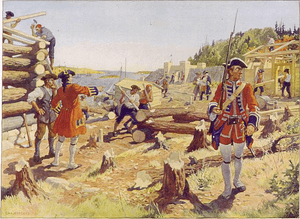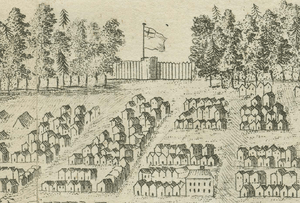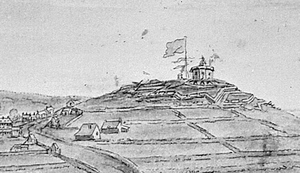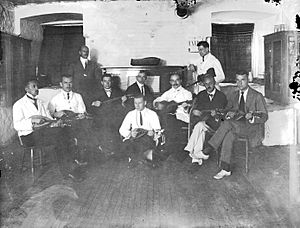Citadel Hill (Fort George) facts for kids
Quick facts for kids Halifax Citadel |
|
|---|---|
| Fort George (1796–1828) | |
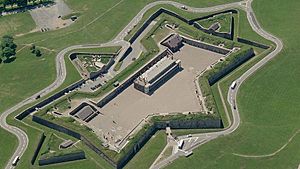
An aerial view of Citadel Hill
|
|
| Location | Halifax, Nova Scotia, Canada |
| Built | 1749 (first Citadel) 1828–56 (present Citadel) |
| Official name: Halifax Citadel National Historic Site of Canada | |
| Designated: | 25 May 1935 |
Citadel Hill is a famous hill and a National Historic Site in Halifax, Nova Scotia, Canada. Imagine a big, strong fort built on top of a hill – that's the Halifax Citadel!
Since the city of Halifax was started by the English in 1749, four different forts have been built on Citadel Hill. They were often called Fort George. However, only the third fort (built between 1794 and 1800) was officially named Fort George. It was named after King George III. The first, second, and the current fourth fort were all officially called the Halifax Citadel. The current fort is a strong, star-shaped building made of concrete.
The Citadel is like the fortified top of Citadel Hill. The hill was first made into a fort in 1749. This was the year Edward Cornwallis helped start the town of Halifax. These forts were rebuilt many times to protect the town from different groups. Over time, building and leveling the hill has made its top ten to twelve meters lower. Even though the Citadel was never actually attacked, it was super important for defending the Halifax Harbour and its Royal Navy Dockyard.
Today, Parks Canada takes care of the site. It's called the Halifax Citadel National Historic Site of Canada. They have made the fort look just like it did when it was built during the Victorian era.
Contents
Past Forts on Citadel Hill
The First Citadel (1749–1776)
The English started Halifax in 1749. They wanted to have a strong base in Nova Scotia. This was to balance the French stronghold of Louisbourg. Halifax was a key place during the rivalry between the English and French. The English brought settlers and built forts. These forts protected them from raids by the French, Acadians, and their allies, the Wabanaki Confederacy (especially the Mi'kmaq). This period of conflict is sometimes called Father Le Loutre's War.
The conflict began soon after Edward Cornwallis arrived on June 21, 1749. He was the new Governor of Nova Scotia. He came with many ships and settlers to establish Halifax.
On September 11, 1749, Cornwallis wrote about the fort. He said the "Square at the top of the Hill is finished." This first fort was a small, strong outpost. It had a flag and a guardhouse. It was part of the city's western wall. This wall was protected by five stockaded forts.
These fortified city walls and forts protected against attacks. Cornwallis also built other forts nearby. These included forts in Bedford, Dartmouth, Lunenburg, and Lawrencetown.
During this time, soldiers in Halifax were always ready. The Mi'kmaq and Acadians attacked the Halifax and Dartmouth area many times. The first attack was in July 1750. The Mi'kmaq killed Cornwallis' gardener and others near Halifax.
In 1751, there were attacks on blockhouses (small forts) around Halifax. In 1753, more attacks happened near the South Blockhouse. A well-known Halifax businessman, Michael Francklin, was captured in 1754. He was held for three months.
These forts were also important during the French and Indian War. This was part of the Seven Years' War. British soldiers in Halifax helped with the expulsion of the Acadians. Many Acadians were held on Georges Island before being sent away. During the war, the Mi'kmaq and Acadians continued to resist the British. In 1757, Acadian Pierre Gautier led Mi'kmaq warriors in raids on Halifax. In one raid, two British men were killed near Citadel Hill.
By 1761, the first Halifax Citadel was getting old. The British decided to build a new one. Plans were made in 1761, but construction was delayed. After the American Revolutionary War started in 1776, the British built the Second Citadel. It was a bigger version of the 1761 plans.
The Second Citadel (1776–1795)
The first big, strong fort on Citadel Hill was finished during the American Revolution. Built in 1776, this new fort had many layers of earth walls. It also had a large outer fence. In the middle was an eight-sided blockhouse. This building had fourteen guns and could hold 100 soldiers. To build this, the hill had to be cut down by 40 feet. The whole fort had 72 guns.
Citadel Hill and the other harbour forts made Halifax a very safe and important base for the Royal Navy. It was a key spot for ships traveling to Europe. This gave Halifax the nickname "Warden of The North." The large British military presence in Halifax, centered at Citadel Hill and the Royal Navy's dockyard, is a main reason Nova Scotia stayed loyal to the British during and after the American Revolutionary War.
Neither French nor American forces attacked Citadel Hill during the American Revolution. However, the soldiers stayed alert. This was because American privateers (private ships allowed to attack enemy ships) raided villages around the province. There were also naval battles off the coast of Halifax.
By 1784, most of the fort was in ruins, except for the blockhouse. During the French Revolutionary Wars, Prince Edward, who was in charge of the military in North America, found the forts were not strong enough. Plans for the Third Citadel were made in 1795. But building the new fort didn't start until 1796, after the Second Citadel was taken apart.
The Third Citadel (1796–1828)
The French Revolutionary Wars started in 1793. This brought a new threat to Halifax. A new citadel was designed in 1794 and finished by 1800. Much of the work was inspired by Prince Edward, Duke of Kent. He was King George III's fourth son and Queen Victoria's father. He was in Halifax from 1794 to 1800. The top of the hill was leveled and lowered another 15 feet. This made space for a larger fort. It looked similar to the final Citadel, with four strong points around a central barracks and storage area. It mostly used earth walls.
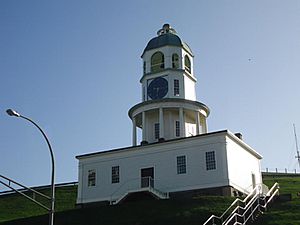
Prince Edward, Duke of Kent ordered the Halifax Town Clock in 1800 before he went back to England. The Halifax Town Clock opened on October 20, 1803. It was placed on the east side of Citadel Hill. It still tells time for the city today. Nova Scotia's first telegraph system was also developed. It sent news of approaching ships to the Citadel.
The Third Citadel was quickly repaired during the War of 1812. This was in case of an American attack. However, the British did not build new forts. The strong British Royal Navy presence made an American attack unlikely. By 1825, most of the fort was in ruins. A new citadel was being designed.
The Current Citadel (1828–present)
Building the current Citadel began in 1828. This large, star-shaped fortress was not finished until 1856. This means it took 28 years to build! It was built during the Victorian Era. This huge stone fort was designed to stop attacks from land or water by United States forces. Its design was inspired by famous French fort builder Sébastien Le Prestre, Seigneur de Vauban. It was a star-shaped fort on a hill. It had an inner courtyard and a clear view of the harbour from its strong walls. Between 1820 and 1831, the British built a similar, but larger, fort in Quebec City. It is known as the Citadel of Quebec.
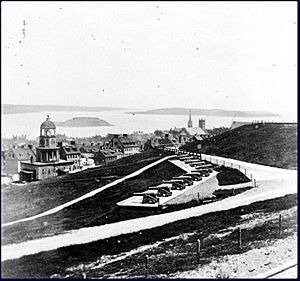
Soldiers at the Halifax Citadel were ready for action during the American Civil War. Nova Scotia was involved in two international events. In the Chesapeake Affair, Confederate supporters from the Maritimes captured a United States ship. American warships then came into these waters to get the ship back. Also, Confederate John Taylor Wood escaped from Halifax Harbour.
The Halifax Citadel was built to defend against older types of guns. It became less useful when more powerful, accurate guns were invented in the 1860s. British forces updated the fort's weapons. They added heavier, more accurate long-range artillery. This allowed it to defend the harbour and land approaches. The Citadel also had two large ammunition storage areas. This made Citadel Hill, according to historian Thomas Head Raddall, "like Vesuvius over Pompeii, a smiling monster with havoc in its belly." By the late 1800s, the Citadel's role changed. It became a command center for other forts further away. It also provided places for soldiers to live.
The 78th (Highlanders) Regiment of Foot stayed in Halifax for almost three years (1869-1871). The regiment arrived on May 14. A total of 765 men got off the ship in their full uniforms. The regiment had many officers, sergeants, drummers, pipers, and soldiers.
For two years, the regiment lived at the Halifax Citadel and at Wellington Barracks. Wellington Barracks is now part of Canadian Forces Base Halifax. Each summer, the soldiers camped at Bedford to practice shooting.
Before they left in 1871, a farewell party was held for them. It included music made just for them. Alexander Keith, the mayor of Halifax and a famous brewmaster, hosted it. On November 25, the regiment sailed to Ireland. Seventeen young Nova Scotian women who had married soldiers went with them. The forts on Citadel Hill were used by the British Army until 1906. After that, the Canadian Army used them during the First World War. The fort was never attacked.
When the First World War started in 1914, many people in Canada were suspicious of immigrants from enemy countries. The government passed rules to watch and hold anyone who had not become British citizens. These people were called "enemy aliens." In total, 8,579 men were held as prisoners of war in 24 camps across Canada.
There were three internment camps in Nova Scotia. One was on Melville Island. Another was at Citadel Hill (Fort George) from September 1914 to October 1918. Unlike other parts of Canada, where most internees were from Eastern Europe, those in Nova Scotia were mainly German reservists.
The last military job for Fort George was to provide temporary housing for soldiers. It also helped with signaling and coordinating the city's anti-aircraft defenses during the Second World War.
Citadel Hill Today: A Living History Museum
In 1935, the hill and its forts were named a National Historic Site. Some work was done to make them stable during the Depression. The fort was not fully restored and started to fall apart after the Second World War. In the late 1940s, some Halifax businesses wanted to tear down the fort. They wanted to level Citadel Hill to make parking and encourage new buildings.
But people realized how important the fort was to history and tourism. This led to the fort being saved and slowly restored. Historian Harry Piers did research that helped this cause. He also helped raise money to restore the Citadel.
In 1956, the partly restored fort opened as a historic site. It also became home to the Halifax Army museum. Before new museums were built, it also housed the Nova Scotia Museum and the Maritime Museum of the Atlantic. In the 1990s, Parks Canada fully restored the Citadel to look like it did in 1869. Parks Canada still manages the site. The fort is one of the most visited National Historic Sites in Atlantic Canada.
The grounds of the Halifax Citadel are open all year. From spring to fall, you can see a "living history" program. People dressed as soldiers from the 78th (Highlanders) Regiment of Foot (who were in Halifax from 1869 to 1871) are there. You can also see the 78th Highlanders (Halifax Citadel) Pipe Band, soldiers' wives, and people showing old trades. Parks Canada also hosts events each year with volunteers who re-enact historical moments.
You can take guided or self-guided tours. There are also videos and exhibits that explain the Citadel's role in the history of Halifax and North America. Every day, all year, a ceremonial noon gun is fired. This reminds everyone of the fort's place in the city's history. The cannons are also used for special events, like 21-gun salutes.
The "Army Museum" is inside the Citadel. It has a special collection of old weapons, medals, and uniforms. It shows the history of the army in Nova Scotia. It's a separate museum that works closely with the Parks Canada staff at the Citadel.
In July 2006, Halifax Citadel celebrated 100 years since the last British soldiers left Canada. The Citadel hosted over 1,000 re-enactors from all over the world. Around Christmas time, Citadel Hill hosts a "Victorian Christmas." Visitors can enjoy crafts, carolers, and games.
Ghost tours are also held at the fort in the weeks before Halloween.
Halifax Defence Complex: Protecting the City
The Halifax Citadel and the forts before it were the main part of the British military's Halifax Defence Complex. This was a network of forts and batteries built to protect Halifax. Over the years, it included many different sites:
- Fort Needham
- HMC Dockyard
- Fort Massey
- Fort Ogilvie
- Prince of Wales Tower
- Connaught Battery
- York Redoubt
- Practice Battery
- Sandwich Point
- Camperdown
- Fort Chebucto
- Fort Charlotte on George's Island
- Fort Clarence
- Devil's Battery / Hartlen Point
- Five forts on McNabs Island:
- Fort Ives
- Fort Hugonin
- Sherbrooke Tower
- Strawberry Hill
- Fort McNab
Images for kids
-
Depiction of Halifax and the surrounding fortifications, 1750. The settlement was protected by city walls and several forts acting as redoubts, including the First Citadel.


